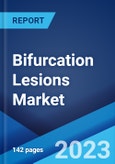The global bifurcation lesions market size reached US$ 2.3 Billion in 2022. Looking forward, the publisher expects the market to reach US$ 3.1 Billion by 2028, exhibiting a growth rate (CAGR) of 5.1% during 2022-2028.
A bifurcation lesion refers to the narrowing of the coronary artery adjacent to the origin of a significant side branch (SB). It is prone to develop atherosclerotic plaque due to turbulent blood flow and high shear stress. It is treated using techniques like analysis, procedure duration, X-ray exposure, and long-term follow-up. Moreover, three-dimensional (3D) angiography and multi-slice computed tomography are utilized for measuring the bifurcation angles. With the advances in devices, imaging, adjunctive pharmacotherapy, and vascular access, the management of complex cases of bifurcation lesions is becoming possible worldwide.
2. What is the expected growth rate of the global bifurcation lesions market during 2023-2028?
3. What has been the impact of COVID-19 on the global bifurcation lesions market?
4. What are the key factors driving the global bifurcation lesions market?
5. What is the breakup of the global bifurcation lesions market based on the application?
6. What are the key regions in the global bifurcation lesions market?
7. Who are the key players/companies in the global bifurcation lesions market?
A bifurcation lesion refers to the narrowing of the coronary artery adjacent to the origin of a significant side branch (SB). It is prone to develop atherosclerotic plaque due to turbulent blood flow and high shear stress. It is treated using techniques like analysis, procedure duration, X-ray exposure, and long-term follow-up. Moreover, three-dimensional (3D) angiography and multi-slice computed tomography are utilized for measuring the bifurcation angles. With the advances in devices, imaging, adjunctive pharmacotherapy, and vascular access, the management of complex cases of bifurcation lesions is becoming possible worldwide.
Bifurcation Lesions Market Trends:
A significant rise in the occurrence of coronary artery disease (CAD) is increasing the risk of developing bifurcation lesions. This represents one of the key factors bolstering the market growth. Besides this, the approval of innovative devices, increasing insurance coverage, and improving imaging modalities are also strengthening the market growth. Moreover, the rising geriatric population, which is more likely to develop medical ailments, along with supportive initiatives undertaken by governments of various countries for reimbursement, is supporting the market growth. The increasing medical tourism, the escalating demand for minimally invasive (MI) procedures and the improving healthcare infrastructure are some of the other factors contributing to the growth of the market. Apart from this, the ongoing research on novel treatment techniques is driving the market. For instance, researchers are studying the effectiveness of the Szabo 2-stent technique for complex bifurcations lesions with high compromise risk or fatal consequences of SB occlusion. Furthermore, a wide range of clinical trials on stents and balloons, in confluence with the increasing number of skilled healthcare professionals, is anticipated to decrease risks associated with bifurcation lesions treatment and influence the market positively.Key Market Segmentation:
The publisher provides an analysis of the key trends in each sub-segment of the global bifurcation lesions market report, along with forecasts at the global, regional and country level from 2023-2028. Our report has categorized the market based on types and application.Breakup by Types:
- One-Stent
- Two-Stent
Breakup by Application:
- Coronary Vascular
- Peripheral Vascular
Breakup by Region:
- North America
- United States
- Canada
- Asia-Pacific
- China
- Japan
- India
- South Korea
- Australia
- Indonesia
- Others
- Europe
- Germany
- France
- United Kingdom
- Italy
- Spain
- Russia
- Others
- Latin America
- Brazil
- Mexico
- Others
- Middle East and Africa
Competitive Landscape:
The competitive landscape of the industry has also been examined along with the profiles of the key players being Boston Scientific Corporation, Cardinal Health, Medtronic plc, Spectranetics (Koninklijke Philips N.V.) and Terumo Corporation.Key Questions Answered in This Report
1. What was the size of the global bifurcation lesions market in 2022?2. What is the expected growth rate of the global bifurcation lesions market during 2023-2028?
3. What has been the impact of COVID-19 on the global bifurcation lesions market?
4. What are the key factors driving the global bifurcation lesions market?
5. What is the breakup of the global bifurcation lesions market based on the application?
6. What are the key regions in the global bifurcation lesions market?
7. Who are the key players/companies in the global bifurcation lesions market?
Table of Contents
1 Preface3 Executive Summary10 Value Chain Analysis12 Price Analysis
2 Scope and Methodology
4 Introduction
5 Global Bifurcation Lesions Market
6 Market Breakup by Types
7 Market Breakup by Application
8 Market Breakup by Region
9 SWOT Analysis
11 Porters Five Forces Analysis
13 Competitive Landscape
List of Figures
List of Tables
Companies Mentioned
- Boston Scientific Corporation
- Cardinal Health
- Medtronic plc
- Spectranetics (Koninklijke Philips N.V.) and Terumo Corporation
Methodology

LOADING...








